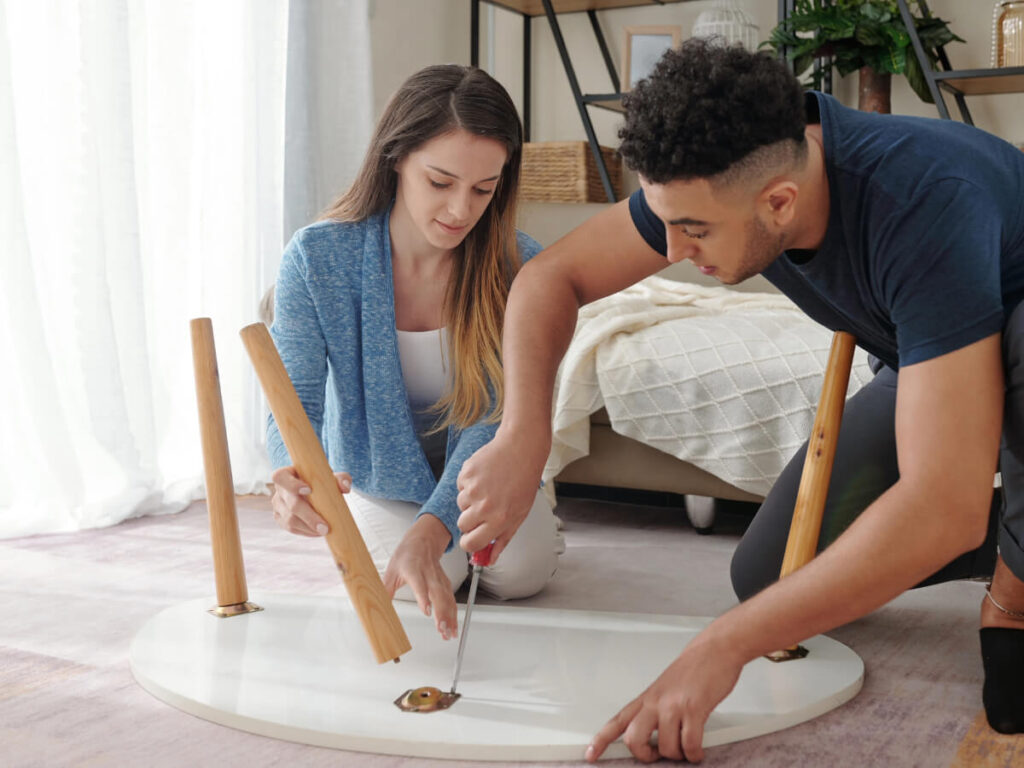You sit down at your dining table, and it wobbles. You try to enjoy a cup of coffee in your favorite chair, and it teeters. Wobbly furniture can be both frustrating and a safety hazard. Whether you have uneven chair legs or loose table joints, we’ve got you covered. Get your tools ready! Here’s your step-by-step guide on how to stop furniture from wobbling.
Why It’s Important to Fix Your Wobbly Furniture
Having a wobble-free home is about more than just convenience. While it may be easy to brush off an off-kilter chair or a shaky dining room table, there are other factors to consider before these issues worsen:
- Safety: Wobbly furniture poses a safety risk. An unstable chair or table can collapse, potentially causing injuries or damage to your belongings.
- Furniture Longevity: Ignoring wobbly furniture can lead to further damage over time. Loose joints can cause irreparable harm, making it costlier to repair the furniture in the long run.
- Aesthetics: Wobbly furniture can disrupt the overall aesthetics of your space. It’s challenging to create a comfortable, welcoming environment with unstable furniture.
- Peace of Mind: Knowing that your furniture is sturdy and secure enhances your peace of mind. You can relax and enjoy your space without worrying about accidents or discomfort.
How to Identify the Root Cause of Unstable Furniture
The first step in learning how to stabilize a table or any other furniture item is to pinpoint the root cause of instability. The most common culprits are:
- Uneven Foundation or Floors: Sometimes, the floor or surface beneath your furniture isn’t level, which can cause wobbling. You can test this by moving the furniture to different spots to see if the wobble persists.
- Loose Hardware: Over time, nuts, bolts, and screws can loosen, leading to instability. Examine your furniture’s joints and connections to identify any loose hardware.
- Uneven Legs: Uneven chair or table legs are a common issue. Furniture legs become unstable due to wear, floor irregularities, or manufacturing flaws. To determine if this is the problem, use a level or simply observe if one leg is shorter than the others.
How to Stabilize a Table
Got a wobbly dining table or a rickety side table? With these steps, they’ll be back to normal in no time.
- Check Table Legs: Place a leveling tool on top of your table to identify which leg is causing the wobble. The bubble in the level will indicate which side is lower.
- Adjust Uneven Legs: Once you’ve identified the uneven leg, place a shim or folded piece of cardboard underneath it. Keep adding shims or cardboard until the table becomes level.
- Secure Table Joints: Loose joints between the legs and tabletop can create instability. Apply wood glue to the joints, and clamp them together until the glue dries to restore stability.
How to Fix Uneven Chair Legs
Of any piece of furniture, wobbly chairs are the most common—and troublesome. Here’s how to fix them.
- Check Chair Legs: A leveling tool can be used if the surface of your chair is relatively flat. If not, wobbling your chair and paying close attention is a simple way to reveal the culprit.
- Install a Furniture Leg Adjuster: Carefully turn the chair on its side, then attach the adjuster to the bottom of the leg. Test the chair’s stability by sitting and rocking gently. Adjust as needed. (Note: Adjusters come in various sizes and materials, so be sure to match the adjuster to its respective chair).
- Add Shims: Another method for fixing uneven chair legs is using shims or small pieces of cardboard. Lift the chair slightly to relieve the weight from the uneven leg. Place a shim or folded piece of cardboard under the shorter leg. Gradually lower the chair back onto the ground. Add or remove shims as needed until the chair is level and no longer wobbles.
How to Fix Wobbly Sofa Legs
A wobbly sofa can cause wear and tear and loss of structural integrity for both the couch and floor it sits on. Here’s how to achieve a wobble-free sofa. These solutions work for beds, too!
- Check Sofa Legs: A leveler will likely not work when inspecting uneven sofa legs. Instead, gently rock the sofa and take note of whichever leg either doesn’t touch the ground or visibly wobbles when disturbed.
- Tighten Loose Screws or Bolts: Flip the sofa upside down to access the legs and their attachment points. Tighten any loose screws or bolts that secure the wobbly leg to the sofa frame with a screwdriver or wrench. Ensure that they are securely fastened, but be cautious not to over-tighten. Doing so could damage the wood or threads.
- Test the results: After tightening, flip the sofa back to its upright position and check if the wobble has been resolved. Sit on the sofa and move around to test its stability.
If the steps above aren’t working and your floor is level, the sofa leg may be damaged. If so, flip the sofa and remove the damaged leg. Take the damaged leg to a furniture or hardware store for a replacement, and ensure the new leg matches the original leg’s style and measurements.
Complete the new leg installation by attaching it securely to the sofa frame with screws or bolts. Then, flip the sofa back to its upright position and test its stability.
Rent-A-Center: The Right Place for Stable Furniture
Wobbly furniture isn’t just a nuisance – it’s an opportunity for transformation. With a diverse selection of rent-to-own furniture, from elegant dining sets to cozy sofas, Rent-A-Center offers reliable, budget-friendly options. Let stability and style reign supreme by exploring options online or at your nearest Rent-A-Center today.

